Kahu-Jo-Darro, also known as Mirpur Khas stupa, is an ancient Buddhist stupa found at the Mirpurkhas archaeological site in Sindh, Pakistan. The site is spread over 30 acres (120,000 m2). Excavations completed before 1910 revealed this large brick-based stupa and numerous terracotta reliefs now displayed in major world museums. The Mirpur Khas site is notable because historic Indian and Arab coins were found during its excavation. This has led scholars such as Derryl MacLean to suggest that Buddhism was thriving in Sindh region around the 10th-century and became extinct in these parts of the west and northwest South Asia after the Islamic conquest.
Buddha from the Kahu-jo-daro stupa, circa 410 CE
The Stupa, before and after excavation
Buddhist stupa of Mirpur Khas
Buddhist stupa of Mirpur Khas (artist's reconstruction)
Mirpur Khas is the capital city of the Mirpur Khas District and Mirpur Khas Division in the Sindh province, Pakistan. Mirpur Khas is the 6th largest city in Sindh province and the 34th largest city of Pakistan. The city was built by Talpur rulers of Mankani branch. According to the 2017 Census of Pakistan, its population is 233,916. Mirpur Khas is known for its mango cultivation, with hundreds of varieties of the fruit produced each year - it is also called the “City of Mangoes,” and has been home to an annual mango festival since 1955. After the completion of Hyderabad-Mirpurkhas dual carriage way, the city has become hub of commercial activities.
Image: Tomb of Mir Tharo Talpur — the ruler of Mirpur Khas — in Chitorri Graveyard
Image: Brahma mirpur khas
Image: Chittori Tombs
The 18th century Chitorri graves were built for the rulers of Mirpur Khas.








